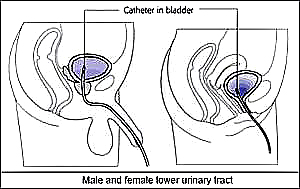Introduction
In general, urinary retention means a complete inability to urinate. In medical terms, it refers to a broader scope which includes:
- Complete inability to urinate (acute urinary retention)
- Inability to completely empty the bladder despite preserve ability to urinate (chronic urinary retention)
Causes of urinary retention
Urinary retention happens when there is narrowing or blockage of the urinary tract, damage to the bladder muscles rendering them unable to contract or disturbance to the nerves that control the bladder muscles (detrusor muscle and the bladder muscle sphincter) that control the opening of the bladder.
- Urinary tract narrowing and blockage
- Benign prostatic hyperplasia or prostate cancer
- Infection of prostatic gland
- Fallen bladder (cystocoele) in menopausal women which commonly occurs together with uterine prolapsed due to weaken pelvic floor muscles
- Urethral stricture because of scarring due to injury or infection, eg. sexually transmitted disease
- Urinary stone stuck in the urethra
- Damage to bladder
- Bladder may be damaged due to direct injury.
- Nerve damage
- Damage of the spinal cord by injury, infection or tumors.
- Drugs that affect the function of nerves or muscles, for example drugs for itchiness (antihistamines), insomnia, depression and anxiety
For elderly, the main causes for urinary retention are prostatic enlargement for male and fallen bladder (cystocoele) for female.
Signs/Symptoms
Chronic urinary retention
Those who have chronic urinary retention may still be able to urinate, but have problem of starting a stream or slow urine stream. They may have unsatisfactory voiding because the bladder is not emptied completely. They may feel an urgent need to urinate but have little success when they get to the toilet. All these will lead them to frequent toilet visits and may affect their daily life activities.
Acute urinary retention
Those who suffer from acute urinary retention can’t urinate at all, even though they have a full bladder. Urine will overload the bladder and this will cause them to feel pain. Bladder mass can be palpable in the lower abdomen. Acute urinary retention may be preceded by symptoms and features of chronic urinary retention or just occur without prior symptoms depending on the cause of the retention.
Complications
Acute urinary retention is an emergency situation which requires immediate attention. It can cause a person to suffer extreme pain due to excessive stretching of the bladder. He or she may have excessive sweats, anxiety, chest pain and raised blood pressure. If not treated immediately, it will lead to bladder and kidney damage.
Long-term effects more pronounced for those with chronic urinary retention because of the tendency for them to ignore or delay seeking treatment. The long-term effects include:
- Formation of kidney stones
- Damaged bladder muscles due to prolonged period of overstretching
- Kidney swelling (hydronephrosis)
- Kidney damage
Treatment
The goal of treatment for urinary retention is to drain the urine out by inserting a catheter tube into the bladder through the urethra tract (urinary catheterization). If this is not possible for some reasons, the bladder can be punctured with a catheter through the lower abdomen (cystostomy).

Urinary catheterization

Cystostomy
Long-term treatment depends on the cause of urinary retention. Treatment involving drugs are usually preferred for elderly with mild to moderate benign prostatic hyperplasia (BPH) (hyperlink). For the more severe, surgery may be indicated. For those who have persistent symptoms despite receiving optimal therapy, the drainage of urine could be done with the help of a catheter. The passing of the catheter could be done by self-insertion or assistant by family member or health professionals.
Surgery is usually needed for elderly female with fall bladder (cystocoele).
Prevention
Urinary retention can be prevented by avoiding taking drugs that may cause acute urinary retention especially for those suffering from prostate enlargement. Get advice from your doctor. Drugs that should be avoided include;
Antihistamines (for cough, cold or itchiness)
- Diphenhydramine (Benadryl)
- Chlorpheniramine (Piriton)
- Loratadine (Clarytine)
- Cetirizine (Zyrtec)
Sedatives (medications that helps with sleep or mood)
- Sleeping pills
- Anxiolytic and antidepressants
In addition, there are a few tips to avoid urinary retention;
- Empty the bladder whenever there is presence of sensation to urinate. Do not postpone. Have a habit of passing urine every 2 to 4 hours to encourage complete bladder emptying.
- Do not rush when urinating; take time to empty the bladder completely.
Rehabilitation
Rehabilitation depends on the cause of urinary retention. Bladder training may sometimes be useful. Bladder training involves teaching a person to avoid bad habits of urination, adopt good practice and to practice pelvic floor muscle strengthening exercises. Your doctors or physiotherapists will be able to advise accordingly.
References
- http://en.wikipedia.org/wiki/Urinary_retention
- http://www.nlm.nih.gov/medlineplus/ency/article/003972.htm
- National kidney and urologic diseases information clearinghouse. “Urinary retention overview” 2010-02-10
| Last Review | : | 09 September 2014 |
| Writer | : | Dr. Mohd Daud bin Che Yusof |
| Akreditor | : | Dr. Cheah Wee Kooi |







